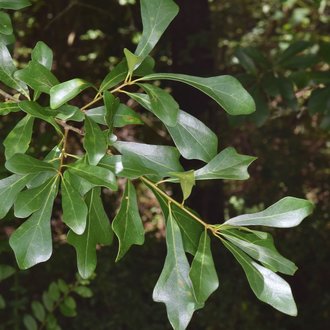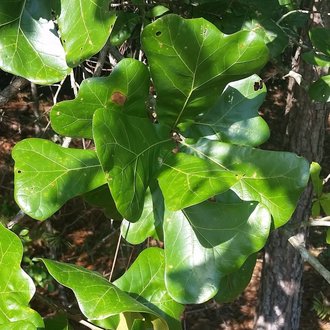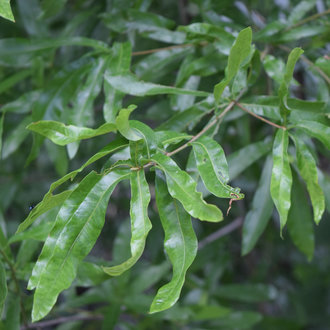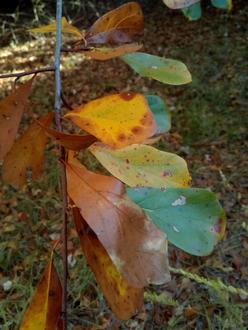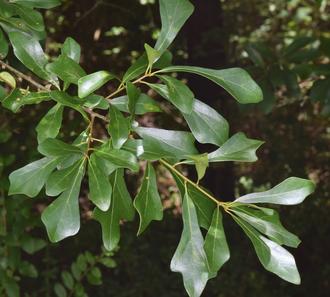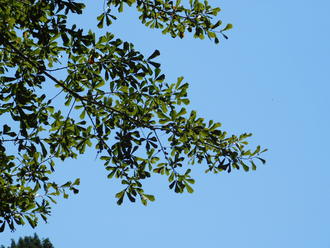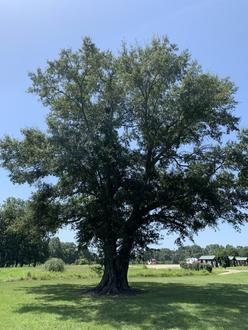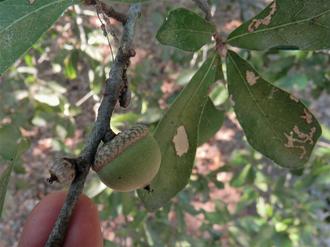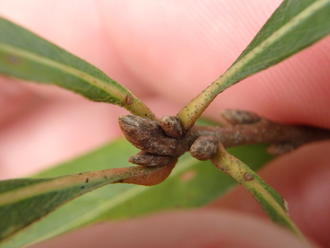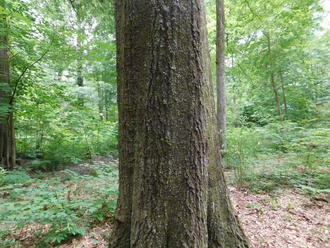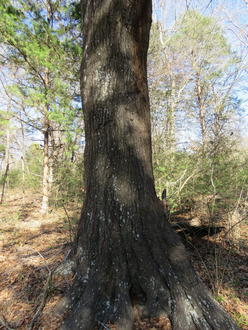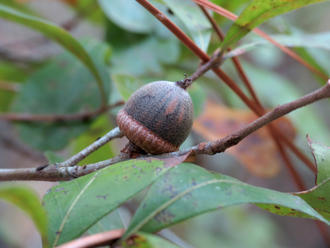Water Oak (Quercus nigra L.)
Also known as possum oak.
↑Summary
A red oak of wet areas in the south, whose tardily-deciduous leaves have a distinct, spatula-like shape.
↑Similar Plants
↑Habitat
Primarily found in bottomland forests in the southeastern U.S., on levees, ridges, and elevated margins of swamps and rivers. Usually found on sites that flood deeply and frequently but drain quickly; also found on uplands to about 1,000 feet (300m) on sites that remain consistently moist.
Grows best on well-drained soils; grows poorly on flat sites with poorly-drained clay soils. Primarily found on inceptisols.
Tolerates several weeks of flooding each season, and can tolerate longer flooding of up to several months if it does not occur regularly.
Usually found in mid-successional stages, invading pine forests where those forests are protected from fire. Can colonize abandoned fields on fine-textured loess soils. Usually eventually replaced by other species on more favorable sites, but it is ideally suited to grow on ridges less than 5 feet (1.5m) above floodplains, and it can persist as a climax species on such ridges.
↑Life Cycle
Water oak is a fast-growing, short-lived tree, somewhat unusual for an oak.
Seedlings emerge late in spring, adapted to avoid spring flooding. Seedlings are initially poorly-equipped to handle flooding. The large seeds give seedlings the ability to survive low-light conditions, drought, and herbivory. However, seedlings require consistent moisture for optimal growth.
Under ideal conditions, seedlings can grow 2 feet per year, rapid for an oak. Seedlings suppressed by shade but with enough light to survive, may grow as slow as 2 inches per year.
Trees begin producing seed around 20 years of age. Good seed crops are usually produced every other year. Acorns are distributed by water, gravity, and animals, including squirrels and blue jays.
Trees of all ages will resprout vigorously from the root system if top-killed.
This species has an unusually short lifespan for an oak; we found a variety of sources report its typical lifespan as 30-50 years, 40-60 years, and 60-80 years; at any rate all of these are shorter than most other red oaks of similar size. Trees can be killed by insect damage and disease, often provoked by a period of drought. Individual trees may live longer, perhaps to 150 years, although uncommonly.
↑Faunal Associations
Like other oaks, this species has a high value to wildlife in part due to supporting a great number and diversity of insects. Most of these do not appreciably damage the tree, but, especially when drought-stressed, it is often attacked by trunk borers, including Enaphalodes beetles or Prionoxystus moths; these borers often precede trunk and heart rot, and root rot, caused by a variety of fungi.
Water oak is of particular value to cavity nesting birds both becaues of its rapid growth and its tendency to quickly rot. It is used as nesting sides by many different birds including red-bellied woodpecker, hairy woodpecker, and great crested flycatcher. Woodpeckers typically are the first to create nests, which then get used by other species in later seasons.
The acorns, which are smaller than some oaks, are eaten by both small mammals, including squirrels and chipmunks, and larger birds, including blue jays, wild turkeys, northern bobwhite, and various waterfowl. This species' tendency to grow both near water and on sloped terrain may be a factor in the greater availability of its acorns to waterfowl. The acorns are high in tannins and thus tend to be consumed later in the season, providing food late in winter when food is scarce.
The foliage of this species is browsed by white-tailed deer, and, although it is quite tough and not necessarily the most nutritious, it can be a key food source in winter when other food is scarce.
The semi-evergreen nature of the foliage also makes this species especially important to animals as cover. Trees are especially valuable as habitat for the southern flying
squirrel, when they occur as a tall midstory under pines.
The invasive Nutria (Myocastor coypus) is a threat to this species as it tends to uproot and eat entire seedlings.
↑Uses
Water oak is used to reforest bottomland sites in the southeast where the land has been cleared for agriculture. Trees perform well on such sites whether seeded or planted, and their rapid growth makes them effective for this purpose.
This species is occasionally used in landscaping, where it is valued for its rapid growth, the distinct shape of its leaves, and its tendency to retain green leaves longer than most oaks, leading it to appear nearly-evergreen in late fall to early winter, especially in the south of its range.
Its use in landscaping is limited by its being weak-wooded and susceptible to limb breakage. Although occasionally used as a street tree, it is not well-suited to this purpose, in part because it has poor pollution tolerance. It is primarily used in landscaping in the south. and only occasionally planted near its northern range limits, but it usually does well in the northern portions of its range too.
It makes an excellent windbreak on moist sites, especially in the north of its range where it is one of the largest broadleaf trees retaining a significant portion of its leaves into winter. As it grows well in the understory of pine forests, it is a natural choice to plant underneath an older pine windbreak that is starting to thin out its lower branches.
Although not among the most important timber species, its wood is similar to other trees of the red oak group, and often sold along with them. Its rapid growth is unfortunately offset by the high portion of rot in larger trees, and the tendency of the wood to split during drying, often due to growth stress; both of these factors contribute to the supply of high-quality lumber of this species not being appreciably cheaper than other red oaks.
Where it is abundant, it is widely used as firewood, where its tendency to split is less of a downside.
↑Related Plants
This species belongs to the red oak group, all of which are closely-related. Within this group it may be closest-related to the Darlington oak (Quercus hemisphaerica), followed by laurel oak (Quercus laurifolia).
However, it is actually more likely to hybridize with other, less-closely-related members of this group, including southern red oak (Quercus falcata), bluejack oak (Quercus incana), willow oak (Quercus phellos), turkey oak (Quercus laevis), shumard's oak (Quercus shumardii), and black oak (Quercus velutina). All of these hybrids have been found in the wild on multiple sites and some are relatively widespread through the overlaps of these species' ranges.
↑Links & External Resources
• Water Oak | The Wood Database (About This Site)
• Water Oak | Fire Effects Information System (FEIS) (About This Site)
• Quercus nigra (Water Oak) | USDA PLANTS Database (About This Site)
• Quercus nigra (Water Oak) | Missouri Botanical Garden Plant Finder (About This Site)
• Water Oak | Virginia Tech Dendrology Factsheets (About This Site)
• Water Oak | Silvics of North America (About This Site)
• Quercus nigra | Biota of North America Project (BONAP) (About This Site)
• Quercus nigra | NatureServe Explorer (About This Site)
• Quercus nigra | Flora of North America (About This Site)
• Water Oak | Maryland Biodiversity Project (About This Site)
• Quercus nigra Linnaeus (Water Oak) | Digital Atlas of the Virginia Flora (About This Site)



